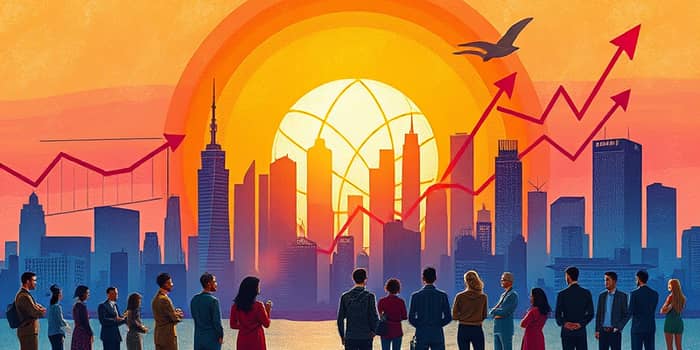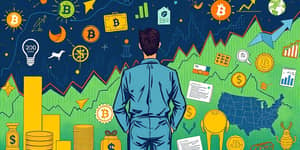In 2025, a confluence of shifting global economic trends, heightened trade tensions, evolving policy priorities, and sustainability imperatives converge to present a pivotal chance for innovation and growth. The roadmap ahead demands ambition, foresight, and adaptability. This article explores the macroeconomic backdrop, outlines the major risks, and provides targeted strategies to help organizations and individuals seize this unique moment and transform uncertainty into a golden opportunity.
By leveraging data-driven insights and deploying flexible frameworks, stakeholders can navigate complexity, accelerate value creation, and secure long-term resilience.
Macroeconomic Backdrop
Forecasts for global GDP growth in 2025 range from 2.4% to 3.0%, reflecting moderate expansion tempered by persistent headwinds. The IMF projects 3.0% growth, closely aligned with S&P Global/EY estimates, while the UN and OECD offer slightly more cautious outlooks. This dispersion underscores the variability of recovery paths across regions and sectors.
Regional outlooks vary significantly. The United States is expected to expand by 1.6%, weighed down by high interest rates and sluggish consumer spending. In contrast, China’s growth will moderate to approximately 4.3%–4.7%, shifting focus from export-led expansion to domestic consumption. India continues to exhibit stable expansion, albeit at a more tempered pace, as it balances infrastructure investments with fiscal consolidation.
Emerging markets face additional volatility from currency swings and commodity price fluctuations. Brazil contends with contractionary pressures, while Russia navigates sanctions and structural headwinds. Collectively, these dynamics emphasize the need for investors to adopt a localized market assessment approach and to align portfolios with regional strengths.
Such data equips decision-makers with clarity, enabling precise timing of market entry and resource allocation.
Trade Disruptions and Policy Shifts
Global trade volumes have stagnated since February 2025, as tariffs and non-tariff barriers inject friction into supply chains. The United States has imposed duties of 50% on Brazilian imports, 35% on select Canadian goods, and continues to enforce 25% tariffs on Mexican products. These measures raise input costs, extend lead times, and complicate just-in-time manufacturing processes.
At the same time, other economies are recalibrating their policy mix. The European Central Bank is pursuing gradual easing, while the Bank of Japan inches toward tighter monetary settings. Fiscal expansion in major jurisdictions, from infrastructure packages in the United States to green transition funds in the European Union, aims to offset monetary tightening and sustain domestic demand.
- Front-loaded fiscal spending creates short-term growth spurts.
- Monetary policy divergence can trigger cross-border capital flows.
- Sector-specific tariffs reshape competitive landscapes.
Firms that develop agile procurement operating models and multi-source supplier network strategies will mitigate disruption risk and safeguard margins in this unpredictable environment.
Inflation and Risk Dynamics
Inflationary pressures are gradually easing, but unevenly across regions. While headline rates are projected to fall from 6.2% to 3.6% in G20 economies, core measures remain stubbornly above central bank targets. In the United States, persistent tariffs on consumer goods keep prices elevated, whereas commodity-driven inflation spikes hit emerging markets with less fiscal buffer.
Uncertainty stems not only from price dynamics but also from shifting geopolitical alliances. US-China tensions, regional water security disputes, and cyber vulnerabilities introduce non-economic risks that can disrupt operations without warning. Financial institutions and corporate treasuries must implement comprehensive scenario stress testing and dynamic hedging and risk strategies to withstand sudden shocks.
Moreover, demographic trends and technological disruptions add layers of complexity. Aging populations in advanced economies strain social safety nets, while automation and AI adoption can both boost productivity and displace labor. Those who embrace technological integration and workforce reskilling may turn challenges into catalysts for growth.
Challenges and Pathways to Resilience
Developing economies confront elevated debt levels and currency risk, limiting fiscal flexibility during downturns. Simultaneously, global supply chain bottlenecks expose vulnerabilities in lean operating models. Companies that over-relied on single-region sourcing now face delays, shortages, and price volatility at critical nodes.
However, embedded within these challenges are clear pathways to resilience. Investment in digital platforms, predictive analytics, and remote collaboration tools can increase operational agility. Diversifying production footprints across strategic hubs—from Southeast Asia to Eastern Europe—reduces dependency on any single market.
- Digital transformation accelerates decision cycles and transparency.
- Regional diversification cushions against localized shocks.
- Public-private collaborations strengthen critical infrastructure.
Resilient organizations cultivate a culture of continuous learning, empowering teams to iterate rapidly on contingency plans and pivot when scenarios deviate.
Seizing the Moment: Strategies for Leaders
Success in 2025 and beyond hinges on the ability to anticipate policy shifts, mobilize resources, and foster innovation. Here are key strategic imperatives:
- Prioritize early engagement in markets benefiting from fiscal expansion and green stimulus.
- Embed ESG metrics into performance targets to capture long-term value and stakeholder support.
- Forge integrated risk management units to unify analysis across finance, operations, and supply chains.
- Leverage strategic partnerships and consortiums to share risk and co-develop breakthrough technologies.
- Adopt scenario-driven strategic planning with rapid decision gates to capitalize on emergent trends.
By aligning core strategies with emerging policy focus areas—such as renewable energy, circular economy models, and digital infrastructure—leaders can secure preferential funding and regulatory support, unlocking new revenue streams.
Moreover, organizations should invest in talent development programs that emphasize cross-functional collaboration, data literacy, and innovation leadership. Such investments not only boost internal capability but also cultivate a workforce capable of navigating complexity.
Conclusion
Although the global economy in 2025 faces a mosaic of challenges—slowing growth, trade frictions, and uneven inflation—this period also represents an unprecedented chance to reimagine business models, enter new markets, and harness sustainable innovation. Stakeholders who adopt adaptive and resilient long-term strategies and resilience and agility frameworks will outpace competitors and shape a more inclusive and prosperous future.
The golden opportunity lies in the willingness to embrace change, to look beyond short-term volatility, and to commit to long-term strategic agility. Now is the time to seize the moment.
References
- https://www.oxfordeconomics.com/key-themes-2025/
- https://www.mckinsey.com/capabilities/strategy-and-corporate-finance/our-insights/global-economics-intelligence
- https://desapublications.un.org/publications/world-economic-situation-and-prospects-mid-2025
- https://www.oecd.org/en/about/news/press-releases/2025/06/global-economic-outlook-shifts-as-trade-policy-uncertainty-weakens-growth.html
- https://www.spglobal.com/market-intelligence/en/news-insights/research/global-economic-outlook-july-2025
- https://www.imf.org/en/Publications/WEO/Issues/2025/07/29/world-economic-outlook-update-july-2025
- https://www.ey.com/en_us/insights/strategy/global-economic-outlook
- https://www.worldbank.org/en/publication/global-economic-prospects










